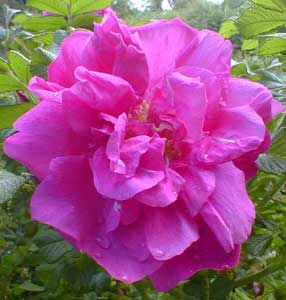
'Magnifica'
Rugosa Rose
"The roses with the west wind rapping
Are torn away, & a splash
Of red goes down the billowing air."
-D. H. Lawrence
(1885‚1930)
(1885‚1930)
Most rugosa rose hybrids have only been bred since the 1970s, but 'Magnifica' is one of the exceptions, a Van Fleet heirloom shrub dating to 1905. This is a double form of the single wild Rosa rugosa or Sea Tomato, although it is often labeled by European growers as R. rubiginosa magnifica. European growers seem to feel it was hybridized with R. rubinigosa, the Applebriar or Sweetbrier Rose, likewise native to China, a major source of rosehip oil, with leaves that are even more heavily scented than its flowers; but the leaves of 'Magnifica' do not have the Sweetbriar odor.
'Magnifica' has been used in many of the more modern hybrid programs for newer varieties. It shares with the majority of rugosas drought hardiness, cold-hardiness, a degree of deer resistance due to the density of its prickly thorns, & does fine in gardens along coasts of saltwater bays or oceans, making rugosas the most significant of all salt-tolerant flowering shrubs. Rugosas are sensitive only in the south, & with careful selection, even heat-hardy rugosas can be found.
It may well be that in fancy-dancy rose clubs, an heirloom rugosa is not nearly as delightful as some rose that needs constant maintenance or gets sickly & spotty in a trice, so that to get a perfect flower means the rose-gardener requires toxic chemicals & a concern for the appearance of nothing but the flower on the constantly pruned & chemical-doused super-hybrids.
But by my standard, those sorts of roses are intolerable, even sometimes eyesores, because the method by which they are cared for too often lends no attention to limb structure, due to complete focus on flowers, constantly being cut back to the detriment of aesthetic structure.
By comparison, a tough hybrid rugosa like 'Mangifica' is beautiful as a shrub, with an upright bushy posture, very densely leafed from spring through summer, nicely bronze-colored in autumn, & when the spine-covered branches are bare in winter, they have an eerie beauty all their own.
Further, 'Magnifica's' three-inch to five-inch red, double, & highly fragrant flowers with yellow heart look as though they are made out of crinkly silk. They are long-lasting in gorgeous bloom. They rebloom without demanding constant deadheading as do fancy roses; indeed, deadheading is not desirable, since the beautiful edible hips add color to the autumn garden (lasting on the branches into winter if not harvested to eat), the fruits being as ornamentally marvelous as the blossoms.
Rugosas do not like to be chemical-doused & are so impervious to disease there's really no reason to treat them in any manner that is not wholly organic. They don't even require much in the way of fertilizing to bloom & fruit extremely well. They like a sunny position, a late winter pruning to remove the oldest canes & make room for new, & that's about it.
On average it grows five or six feet tall, but can get taller, & can spread much wider if its suckers are not removed. It can be trained as an impregnable hedge.